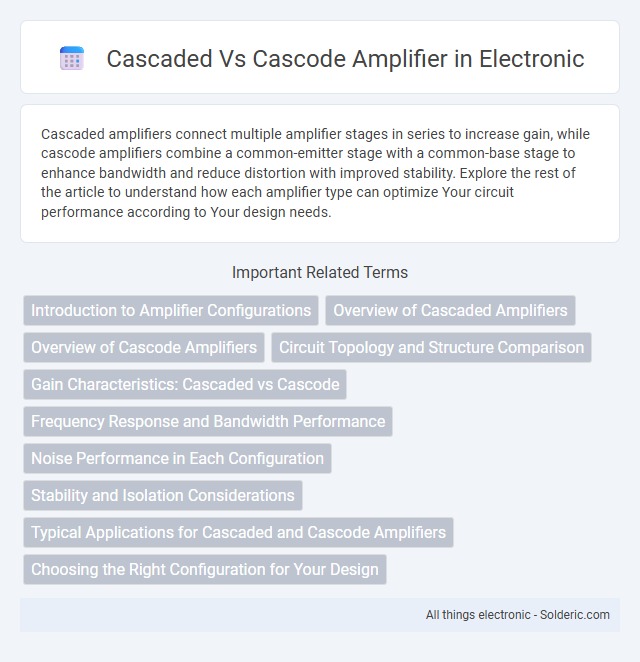Cascaded amplifiers connect multiple amplifier stages in series to increase gain, while cascode amplifiers combine a common-emitter stage with a common-base stage to enhance bandwidth and reduce distortion with improved stability. Explore the rest of the article to understand how each amplifier type can optimize Your circuit performance according to Your design needs.
Comparison Table
| Aspect | Cascaded Amplifier | Cascode Amplifier |
|---|---|---|
| Topology | Multiple amplifier stages connected in series | Combination of common-emitter and common-base stages |
| Gain | High, product of each stage's gain | High gain with improved bandwidth and stability |
| Bandwidth | Reduced due to cumulative Miller effect | Wide bandwidth, Miller effect minimized |
| Input-Output Isolation | Limited isolation between stages | Good isolation, reducing feedback and distortion |
| Output Impedance | Varies, generally moderate | High output impedance |
| Noise | Can accumulate noise over stages | Lower noise due to reduced Miller capacitance |
| Power Consumption | Depends on number of stages and biasing | Generally higher due to two-transistor configuration |
| Application | General amplification where gain is prioritized | High-frequency amplification and RF circuits |
Introduction to Amplifier Configurations
Cascaded amplifiers consist of multiple amplifier stages connected in series to achieve higher overall gain by multiplying individual stage gains. Cascode amplifiers combine a common-emitter stage feeding into a common-base stage, enhancing bandwidth and reducing Miller effect while maintaining high gain. Both configurations optimize performance based on application requirements, with cascaded amplifiers focusing on gain enhancement and cascode amplifiers emphasizing frequency response and stability.
Overview of Cascaded Amplifiers
Cascaded amplifiers consist of multiple amplifier stages connected in series, each stage boosting the overall gain while allowing for improved bandwidth and input-output impedance matching. This configuration enables higher overall voltage gain compared to a single stage without significantly compromising stability or linearity. The design flexibility of cascaded amplifiers makes them ideal for applications requiring substantial signal amplification across wide frequency ranges.
Overview of Cascode Amplifiers
Cascode amplifiers combine a common-emitter stage with a common-base stage to achieve high gain and wide bandwidth while minimizing the Miller effect. This configuration enhances frequency response and provides better input-output isolation compared to cascaded amplifiers, making it ideal for RF and high-frequency applications. Cascode amplifiers also offer improved linearity and higher output impedance, which contribute to their superior performance in precise analog circuits.
Circuit Topology and Structure Comparison
Cascaded amplifiers consist of multiple amplifier stages connected in series, where each stage amplifies the signal independently, resulting in increased overall gain and bandwidth. Cascode amplifiers combine a common-emitter (or common-source) stage with a common-base (or common-gate) stage, offering high gain with improved frequency response due to reduced Miller effect and increased output impedance. The cascaded topology emphasizes modular amplification stages, while the cascode structure integrates transistor configurations to enhance high-frequency performance and stability.
Gain Characteristics: Cascaded vs Cascode
Cascaded amplifiers multiply the voltage gains of individual stages, resulting in a high overall gain but with increased noise and potential bandwidth limitations. Cascode amplifiers offer moderate gain per stage while significantly improving gain-bandwidth product and reducing Miller effect, leading to better frequency response and stability. The cascode configuration typically provides superior gain linearity and higher output impedance compared to cascaded amplifiers.
Frequency Response and Bandwidth Performance
Cascaded amplifiers generally provide higher gain but suffer from reduced bandwidth due to the cumulative effect of each stage's frequency limitations, causing a narrower overall frequency response. Cascode amplifiers enhance bandwidth and frequency response by minimizing the Miller effect, which significantly reduces input capacitance and improves high-frequency gain stability. For your high-frequency applications, cascode configurations offer superior performance with extended bandwidth and better high-frequency operation compared to cascaded stages.
Noise Performance in Each Configuration
Cascaded amplifiers tend to accumulate noise from each stage, which can degrade the overall noise performance, making them less ideal for low-noise applications. Cascode amplifiers, by combining common-source and common-gate transistors, significantly reduce the Miller effect and improve bandwidth while maintaining superior noise characteristics. Your choice between these configurations should consider the trade-off between gain, bandwidth, and noise requirements in your specific application.
Stability and Isolation Considerations
Cascode amplifiers offer superior stability and isolation due to their inherent configuration, which minimizes Miller effect and reduces input-output feedback, resulting in enhanced bandwidth and gain stability. Cascaded amplifiers, while simpler, often suffer from increased parasitic capacitances causing potential oscillations and less effective isolation between stages. Superior isolation in cascode designs improves frequency response and reduces distortion, making them a preferred choice in high-frequency and RF applications.
Typical Applications for Cascaded and Cascode Amplifiers
Cascaded amplifiers are commonly used in audio systems and communication devices where high gain and wide bandwidth are required, such as in radio receivers and signal processing circuits. Cascode amplifiers excel in high-frequency applications, including RF and microwave amplifiers, due to their superior gain stability and reduced Miller effect, making them ideal for low-noise amplifier stages in wireless transmitters. Your choice depends on whether your design needs optimal bandwidth and gain (cascaded) or enhanced frequency response and noise performance (cascode).
Choosing the Right Configuration for Your Design
A cascaded amplifier consists of multiple amplifier stages connected in series, providing high overall gain but with increased noise and potential stability issues. A cascode amplifier combines a common-emitter stage with a common-base stage, offering high gain and improved bandwidth while significantly reducing Miller effect and noise. Choosing your design depends on whether you prioritize gain with simplicity (cascaded) or enhanced frequency response and noise performance (cascode).
Cascaded vs Cascode amplifier Infographic

 solderic.com
solderic.com